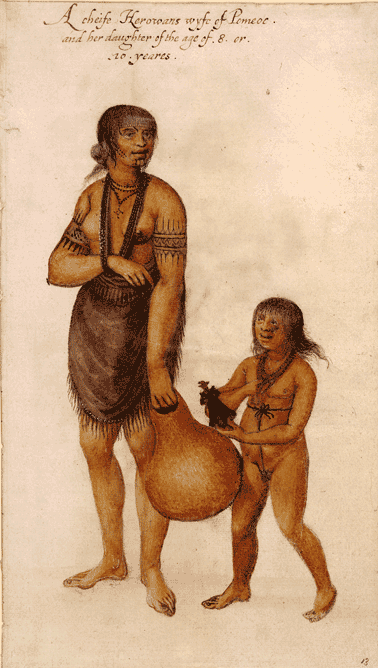
 |
||
The Yale Alumni Magazine is owned and operated by Yale Alumni Publications, Inc., a nonprofit corporation independent of Yale University. The content of the magazine and its website is the responsibility of the editors and does not necessarily reflect the views of Yale or its officers. |
|
Object Lesson John White, a sixteenth-century English traveler, was perhaps best known as a founder and, briefly, the first governor of what would become the “Lost Colony” of Roanoke. But White's longest-lasting contribution may be the superb watercolors he painted in July 1585 of the Native Americans he and his fellow explorers encountered in “Virginia,” as they called North Carolina. For Europeans, these were the first depictions of the inhabitants of the “New World.” His work, which was converted to copperplate engravings and published in a host of widely popular travel books, has achieved iconic status for generations of admirers.
White’s images of individual Algonquian people and their customs leave an especially indelible impression. This example, of “a chief’s … wyfe and her daughter of the age of 8 or 10 yeares,” typifies the series as a whole. White’s technical proficiency is immediately evident in his confident rendering of line, color, and form. He had been instructed to portray the Indians true to their actual appearance. Thus the chief’s wife is presented with meticulous attention to her distinctive clothing, jewelry, and tattoos; moreover, her very posture and gaze set her off from European contemporaries. She takes a firm, yet unthreatening, stance; as Harvard historian Joyce E. Chaplin has remarked, she “seems comfortable in her own skin.” She holds a large and nicely fashioned gourd (for carrying water); this would suggest, to transatlantic viewers, a degree of technological sophistication, and the possibility of meaningful contact across racial and cultural lines. The presence of her daughter adds an attractive note of domesticity. Taken as a whole, the painting invites interest, outreach, hope. In actual fact, during White's tenure at Roanoke, hope was in very short supply. The colonists proved incapable of sustaining themselves in such a radically unfamiliar environment, and their relations with local Indians went badly off track. Perhaps the latter saw these newcomers as the competitors they indubitably were, for land and other valuable resources. At any rate, warfare ensued; and within another few years the colony was truly lost forever. Which makes one feature of the “chief’s wife” portrait especially intriguing: the English doll, complete with Elizabethan ruff, thrust forward by the child in a gesture of emphatic display. (The artist had a grand-daughter of his own, the first white—or White—child born anywhere in North America; Virginia Dare was her name. Might she, too, have owned and flourished an Elizabethan doll?) Such an object could only have come from one of White’s fellow colonists; hence it plainly implies trade. But does it also, just possibly,
suggest that the little Algonquian girl might someday come to resemble those
selfsame colonists, whose “civilizing” goals for the “savage” natives were
meant to rationalize and justify their entire project of “New World"
expropriation? One way or another—through assimilation or extermination—the
Indians would be made to go away. |
|
|
|
|
|
|
|
|
©1992–2012, Yale Alumni Publications, Inc. All rights reserved. Yale Alumni Magazine, P.O. Box 1905, New Haven, CT 06509-1905, USA. yam@yale.edu |
||
